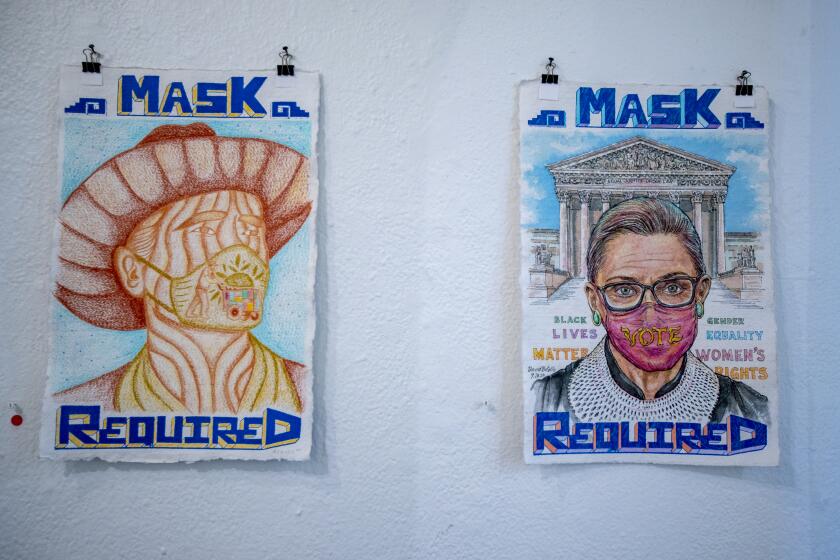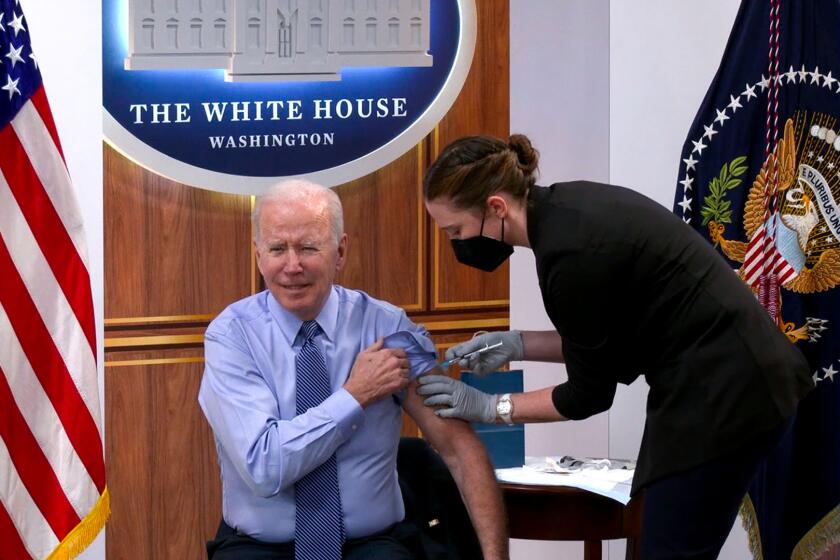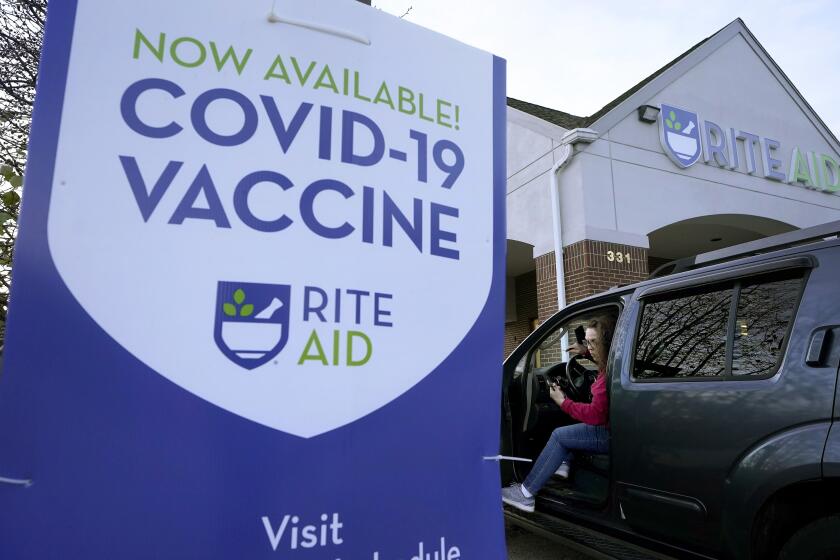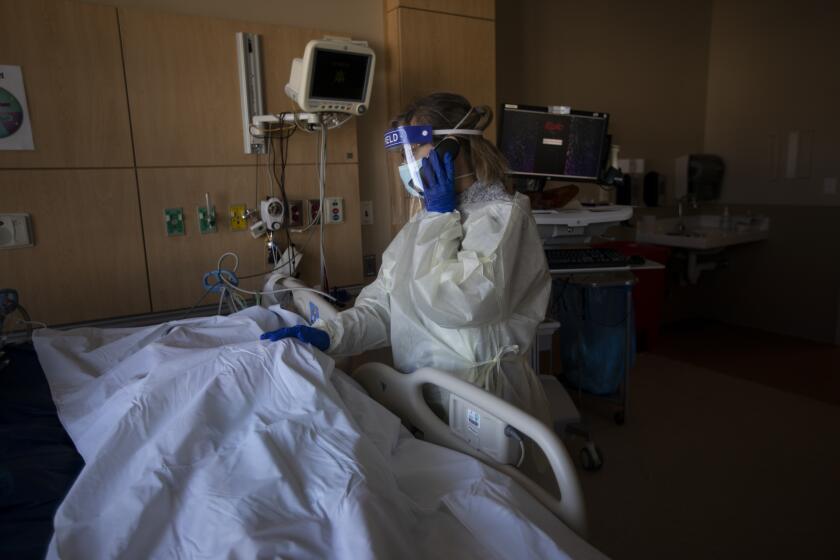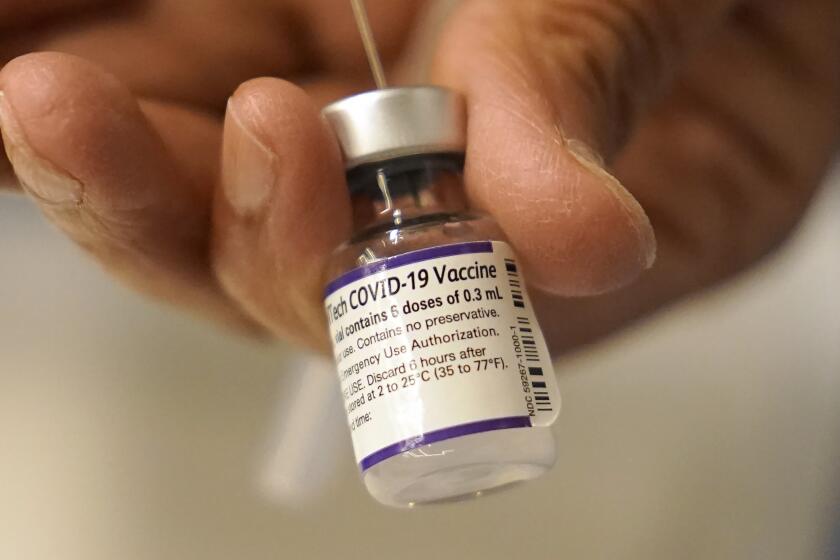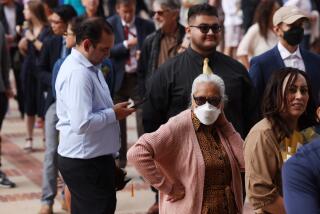Coronavirus cases are spiking elsewhere. Will L.A. County be hit hard or be spared?
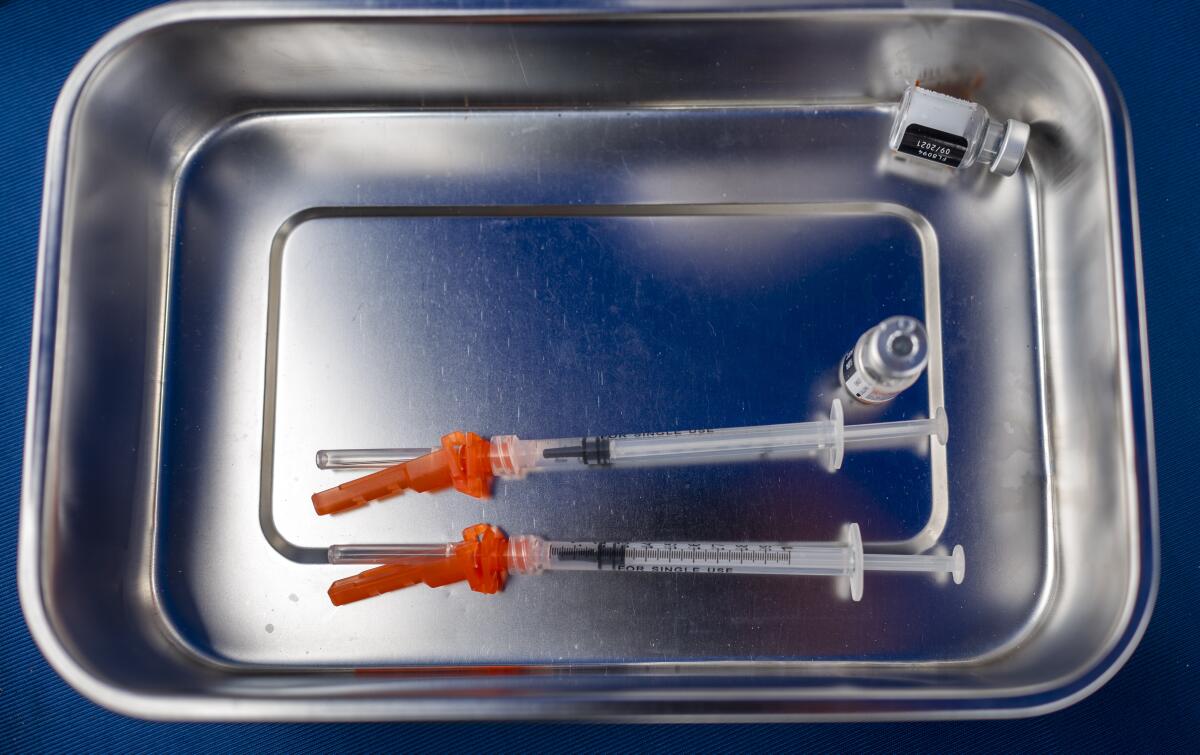
After dramatic declines in coronavirus cases, Los Angeles County has hit another plateau this week that comes amid the spread of the highly infectious BA.2 Omicron subvariant.
BA.2 has led to new increases in cases in other areas, from a significant surge in Britain that has resulted in an increase in hospitalizations and deaths, and the apparent beginning of a wave in New York and Massachusetts.
Similar trends have not yet been seen in Los Angeles County or in California overall, and officials can’t say with certainty what will come next.
Although it is possible that California could see an echo of what Britain is seeing, some experts have also said that the state’s winter Omicron surge — which brought many hospitals under pressure in Southern California and the Central Valley — could help provide some protection against a possible BA.2-fueled surge.
Nationally, the decline in new coronavirus cases may have ended in just the last few days, with the U.S. Centers for Disease Control and Prevention reporting about 26,000 new cases a day, a number that has stayed essentially stable in the last week. It’s the lowest figure since July, but still above the pre-Delta surge number of about 12,000 cases a day in June.
L.A. County’s public health director said the best way to prepare for the coming weeks is to get up to date on vaccinations and booster shots and to wear masks in indoor public settings.
“At some point, we knew that it was likely we were going to stop declining because we know that there’s still transmission. We know that there are still people who are getting exposed,” L.A. County Public Health Director Barbara Ferrer said during a briefing Thursday. “Personally, I wish we were at a lower level when we’re doing this plateauing, but we have seen a significant decrease, and that is the good news.”
BA.2 has already fueled a new wave of infections across other parts of Europe and Asia. It can still be quite deadly in areas where vaccination rates are relatively low, as is the case among Hong Kong’s elderly population. A devastating spike in cases has led Hong Kong to run short on coffins.
Some experts believe California is well-armored against another potential coronavirus surge, but BA.2 has fueled substantial increases abroad.
BA.2 is believed to be 30% to 60% more contagious than the original Omicron variant that spread through California last winter.
BA.2 is now estimated to be the dominant version of the coronavirus circulating nationwide, which underscores the need for continued caution, Ferrer said.
“Given the increased risk for spread of BA.2, it is important that we take steps now to maximize protection against spread,” she said. “Encouragingly, the [World Health Organization] reported that in countries with high levels of vaccination, especially among those most vulnerable to COVID-19, the recent increase in cases has not translated yet into high rates of hospitalizations or deaths.”
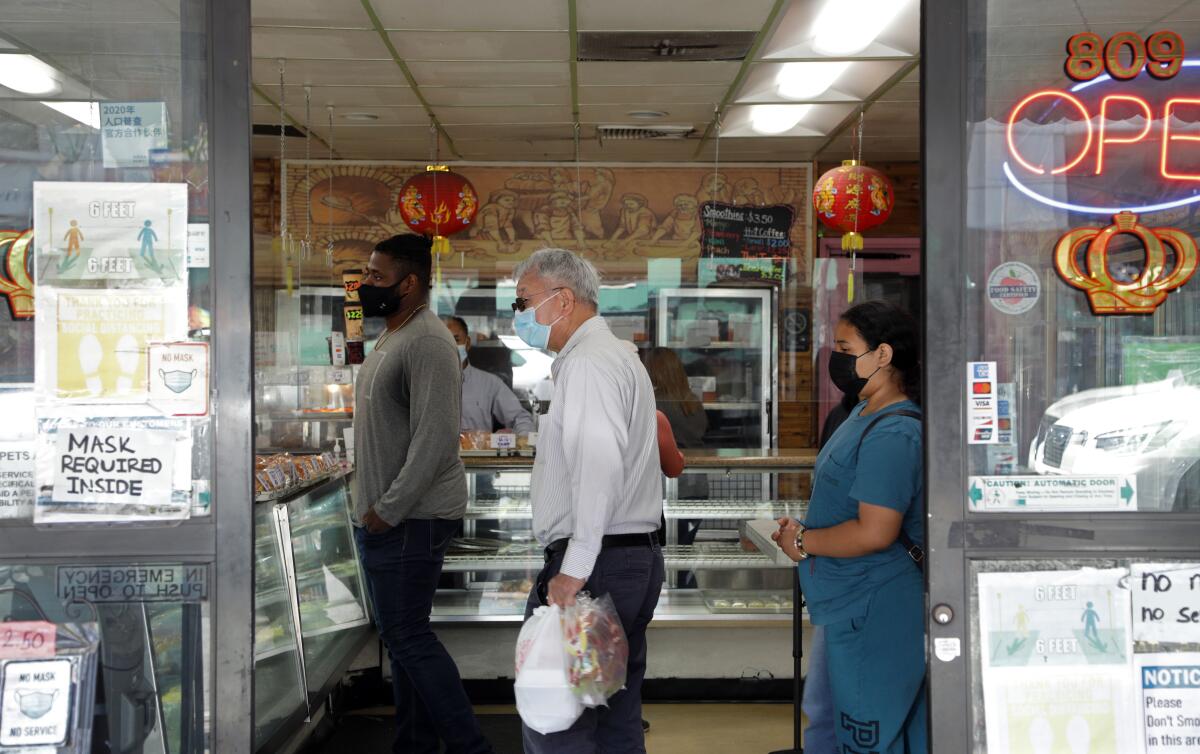
But Ferrer has warned that L.A. County still needs more people vaccinated and boosted. In L.A. County, 1.7 million people ages 5 and older haven’t received a single dose of vaccine, and an additional 2.8 million vaccinated residents age 12 and up who haven’t received their first booster.
According to a county tally, which does not include cases reported late due to a backlog, L.A. County is averaging about 725 coronavirus cases a day, or 50 cases a week for every 100,000 residents — considered on the edge between a moderate and substantial level of transmission. The last time cases were consistently this low was last summer, when California was still basking in the afterglow of its full economic reopening.
The number of hospitalized COVID-19 patients has also tumbled to one of the lowest levels of the entire pandemic. On Thursday, 287 such individuals were hospitalized countywide. At the height of the Omicron surge in January, COVID-19 hospitalizations peaked at 4,814.
‘Don’t delay’: Now is the time for those at higher risk from COVID-19 to get a second vaccine booster dose, L.A. County’s public health director says.
However, the county’s coronavirus case rate stopped consistently falling about a week ago.
L.A. County’s most recent rate of 50 cases a week for every 100,000 residents was higher than the previous week’s rate of 44. The week before that, L.A. County’s case rate was 60; and prior to that, it was 77.
A rate below 50 is considered a moderate level of transmission, according to the CDC. Below 10 is deemed a low level of transmission.
Trends vary by region, and case rates in mid-March were influenced by a backlog of late-reported cases that reflected infections from the winter Omicron surge. “The California Department of Public Health is aware of these reporting delays, which affect case counts across many parts of the state,” L.A. County health officials said March 21.
Orange County is still seeing case rates fall. For the week ending Thursday, California’s third most populous county was reporting 26 cases a week for every 100,000 residents. The prior week’s rate was 47. The week before that, it was 52.
The latest maps and charts on the spread of COVID-19 in Los Angeles County, including cases, deaths, closures and restrictions.
In the San Francisco Bay Area, the case rate trend is essentially flat. The most recent rate was 64 — identical to the previous week’s, but higher than the prior week’s rate of 53.
Some parts of the country where BA.2 became dominant earlier have seen a sustained increase in cases. New York City’s case rate is 104; the prior week, the rate was 83. But hospitalizations are still declining there.
Two bellwether states in the U.S. are New York and Massachusetts, where BA.2 comprises more than 80% of new cases, according to Dr. Eric Topol, director of the Scripps Research Translational Institute in La Jolla.
In a tweet, Topol said New York’s and Massachusetts’ BA.2 wave was starting at a case rate about one-third of that seen when the first Omicron wave began last fall. Topol said it was too early to know how big a BA.2 wave will ultimately be, but suggested it’ll be “likely much less” than the first Omicron wave.
In Britain, health officials estimated a record number of new coronavirus infections in a single week. The Office for National Statistics projected that 1 in 13 residents tested positive for the coronavirus in England between March 20 and March 26; while in Scotland, 1 in 12 tested positive.
The BBC reported some hospitals in Britain coming under pressure, with facilities in Scotland seeing record high numbers of coronavirus-positive patients, although few of them are critically ill.
But not all European countries are seeing a BA.2-fueled surge. Spain’s case rate has essentially been steady throughout all of March.
Most Californians favor keeping COVID-19 vaccine requirements in place even as governments ease the rules, poll finds.
Although a Delta infection didn’t necessarily provide much protection against Omicron, recently surviving the earlier Omicron subvariant BA.1 probably provides additional short-term protection against BA.2.
L.A. County’s recent experience is not necessarily a surprise. As Ferrer noted: “Every single time we have reduced the restrictions or the levels of protection that are required, we have always seen an uptick.”
“Our job right now is to make sure that this doesn’t lead to a significant increase in cases because that really would be, in some ways, a step that I think is avoidable,” she said.
Deciding how many Americans we are willing to let die of COVID-19 each year is necessary to put the pandemic behind us.
Over the last month and a half, L.A. County has relaxed its outdoor masking rules, lifted an order for residents to wear masks in indoor public settings; and rescinded the requirement for patrons to provide proof of COVID-19 vaccination at indoor bars, wineries, breweries, distilleries, nightclubs and lounges.
Separately, the L.A. City Council on Wednesday voted to officially strike a set of far-more-expansive vaccine-verification rules, which also applied to indoor restaurants, gyms, movie theaters and numerous other businesses.
California on Friday also lifted a requirement for attendees to show proof they’ve been vaccinated for COVID-19 or recently tested negative for the coronavirus as a condition of entering indoor events with more than 1,000 people, such as concerts, conventions and sporting contests.
The FDA and CDC offered little guidance about who should get the newly authorized second COVID-19 booster shot. We break it down.
Given how widely rules have been relaxed, officials say it’s vital to closely monitor metrics that could point to a coronavirus resurgence.
An early indication of a potential rise in confirmed coronavirus cases involves detecting viral levels in wastewater. So far, there’s no clear indication of an elevated increase of the virus in sewage in L.A. County, Ferrer said. One bit of data shows a potential rise in coronavirus levels in wastewater coming from the city of Los Angeles recently, but it’s also possible the data just represents a lot of fluctuation and may not be indicative of a trend.
“There’s been a lot of variation in wastewater concentration that was noted over the first two weeks in March. And it’s unclear to us right now if this is really an upward trend,” Ferrer said.
“If we see these continued increases,” she added, “it may provide us with an early alert that cases could soon be rising.”
Ferrer said another early sign of trouble would be a sudden increase in coronavirus-related visits to emergency rooms, which in the past have preceded increases in reported coronavirus cases.
The good news is that as of Sunday, only 3% of emergency room visits in L.A. County were related to the coronavirus, Ferrer said. “This is another positive sign of lower transmission — that despite the BA.2 increases that we’re starting to see — they’re not resulting yet in increases in COVID-19 related [emergency department] visits,” Ferrer said.
Ferrer urged that people get up-to-date on their vaccinations, including seeking a second booster shot for those age 50 and up who are at higher risk of COVID-19 complications should they get infected.
There continue to be significant complications that survivors of a coronavirus infection can face, such as long COVID and increased risk of heart disease and diabetes. That “really should give all of us another reason to double down on efforts to avoid getting infected as much as possible,” Ferrer said, including wearing a mask in indoor public settings, which remains strongly recommended by L.A. County and state health officials.
More to Read
Sign up for Essential California
The most important California stories and recommendations in your inbox every morning.
You may occasionally receive promotional content from the Los Angeles Times.
